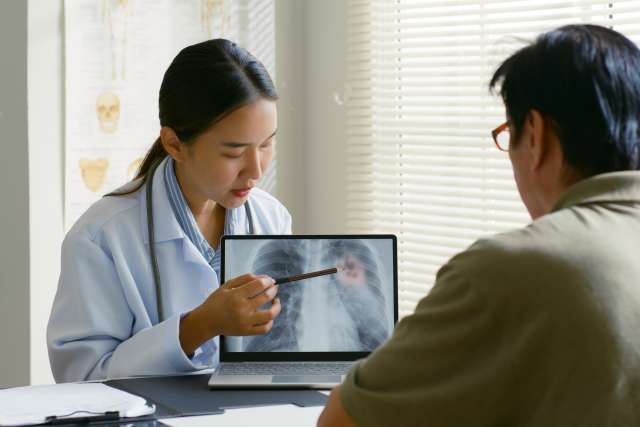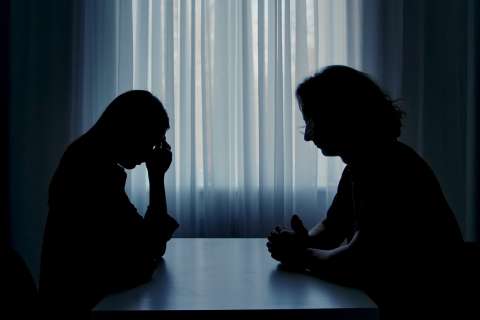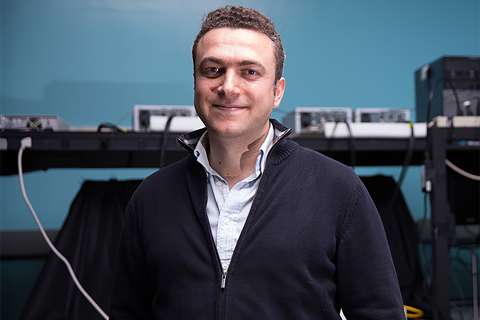A new University of California website promoting lung cancer screening has launched with a goal of saving more lives by improving the state’s dismal screening rate.
UC Screen California, developed by the University of California Lung Cancer Consortium, helps people with a history of smoking quickly and confidentially determine if they qualify for lung cancer screening, said UCLA Health thoracic oncologist Amy Cummings, MD, PhD.
The non-invasive chest CT looks for signs of asymptomatic cancer at the earliest stages, when treatment is most successful.
“We know that screening can save lives,” said Dr. Cummings, who led the website’s creation as part of the consortium’s Lung Cancer Screening and Prevention Task Force.
For website visitors who qualify for screening, the site also goes a step further and provides care navigation throughout the state, linking patients to scheduling, transportation, respite or childcare resources and other related services.
The website taps into a rich network of health care providers that offer lung cancer screening, ranging from UC health systems to community hospitals to private imaging centers.
“It’s not just for UCLA or UC patients,” said Dr. Cummings, who is a member of the UCLA Health Jonsson Comprehensive Cancer Center (JCCC). “It’s meant for anyone who can find it valuable.”
The website had a soft launch Nov. 1 and will continue to be developed into next year.
The consortium’s Screening and Prevention Task Force, which created the website, is co-chaired by UCLA Health’s Ashley Prosper, MD, a radiologist specializing in cardiothoracic imaging and member of the JCCC; and David Cooke, MD, a thoracic surgeon at UC Davis.
Early detection
Lung cancer is by far the leading cause of cancer death in the U.S., according to the American Cancer Society. Each year, more Americans die of lung cancer than colon, breast and prostate cancers combined.
Lung cancer screening, which is done by low-dose computed tomography (LDCT), looks for nodules, which are abnormal growths that can be a sign of lung cancer.
Undergoing the screening is simple and quick, Dr. Cummings noted. There’s no advance preparation or blood work. This type of CT scan doesn’t require contrast and the radiation exposure is low.
Most findings come back normal, with the person advised to return in one year for another scan, she said.
But only 1% of Californians who are eligible for screening are getting it done, with many likely not knowing about LDCT or realizing they qualify. Others may be reluctant to share their smoking histories with their health care providers.
The process for determining eligibility is more complex than for other cancer screenings that rely on age or sex. For low-dose CT, the guidelines are based on age and how much a person has smoked over time.
“One of the main eligibility criteria is a history of smoking and smoking a certain amount in a lifetime,” Dr. Cummings said. “That can be hard to capture from medical records and patient histories.”
To simplify the eligibility process, the UC website invites visitors to briefly answer a few questions to see if they qualify, with the message: “Two minutes could save your life.”
After establishing age and if a person has ever smoked, the site asks whether a person has smoked in the past 15 years, noting that even a couple of puffs count.
It then asks how many years a person smoked, rounded up to the nearest year. Finally, it asks, on average, when a person smoked the most how much did they smoke per day.
This question can be the most difficult part of determining eligibility, in part because it relies on memory and smoking habits can fluctuate.
For instance, Dr. Cummings said, people may have periods where they stop smoking and then start again, or times in their lives where they smoked more or smoked less.
“To get a true estimate is sometimes challenging,” she said. “I think people tend to underestimate when they’re giving this information to physicians.”
Once a person anonymously submits those answers, the site will instantly say if screening should be done.
The U.S. Preventive Services Task Force (USPSTF) and the American Cancer Society both recommend annual screening from ages 50 to 80. Additionally, they say a person must also have smoked for a minimum of what’s known as “20 pack-years.”
Pack-years are calculated by multiplying the number of packs of cigarettes smoked per day by the number of years a person has smoked. For example, a person who smoked one pack of cigarettes per day for 20 years or two packs per day for 10 years would qualify.
The website takes care of all the math. Users can also submit fractions for the calculation, such as a half-pack.
“It gives you the ability to understand whether you meet the guidelines,” Dr. Cummings said.
The groups differ in their recommendations for people who no longer smoke. USPSTF says people should have smoked within the last 15 years to be screened, while in early November the American Cancer Society changed its guidelines to say people who otherwise qualify should be screened regardless of how long ago they quit.
The UC Screen website is following the American Cancer Society’s eligibility guidance.
Individualized help
If a user meets the eligibility guidelines for screening, the site will offer to connect the person with a care navigator to help make an appointment and coordinate any needed aftercare.
“Where the real value of the website comes in is that extra level of support,” Dr. Cummings said.
To connect with a navigator, users need to create an account. The navigators are employees of the various health care entities that provide the screenings. They help answer questions and can arrange care among various departments.
For instance, Dr. Cummings said, sometimes the LDCT might reveal a condition unrelated to lung cancer and the person getting screened might need follow-up from another specialty.
Even without registering on the website, users can enter a ZIP code and a list of screening locations will show up. People can also find information on symptoms of lung cancer, transportation to get screened and insurance coverage. The website offers guidance for uninsured people on how to get the test paid for.
“If you don’t have a doctor, we’re going to connect you to a doctor who can help you,” Dr. Cummings said. “It’s easy to get overwhelmed by health care, particularly in California. This is making it as easy as it can be.”
While areas such as Los Angeles have plentiful options, she said that isn’t the case in some rural areas and Native American reservations.
She said the information on the website could provide a roadmap for where mobile lung cancer screening could eventually be deployed to reach people in more isolated areas.
The website can also help people keep track of their screening schedule. If users create an account, the site will check in to see if they got scanned. They’ll also receive reminders for when their next screening is due.
The website launched in English and Spanish, but Dr. Cummings said the goal is to have 10 languages available next year.
Improving rates
According to the American Lung Association, nationally, nearly 6% of eligible people are getting screened for lung cancer. But in California, the figure is only 1%.
“That was tied for the lowest in the nation,” Dr. Cummings said. “It was so shocking to us that we dug into the statistics to make sure they were right. Lung cancer screening came out as our No. 1 priority as a consortium.”
Dr. Cummings said within the UC system, the lung cancer screening rate is 20% to 30% of eligible patients. She said by 2025, UC wants to hit 40%. By 2030, the goal is to have California overall reach the national average.
“We go across California; we touch so many Californians’ lives,” Dr. Cummings said. “If we were to invest and leverage all our connections, we can move the needle in a meaningful way.”
Courtney Perkes is the author of this article.





